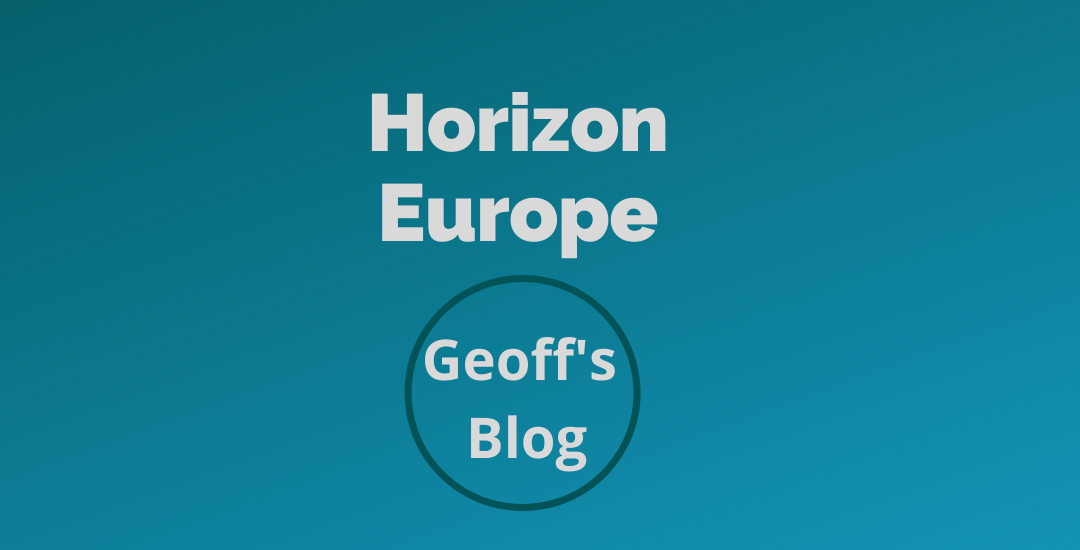- October 4, 2021
- Posted by: EARSC
- Categories: Blogs, European EO Industry, Geoff's Blog

By Delphine MIRAMONT
The Earth Observation Downstream services industry is a cutting-edge and fast moving sector for which innovation is key to provide new products and services. As a result, research is very important for the development of the business and its competitiveness.
Horizon Europe is the European Union research and innovation framework programme with a value of €95, 5 billion for the period 2021-2027. Renewed every seven years, the programme was previously known as “Horizon 2020”. Aligned with the ambitious objectives of the European Green Deal, Horizon Europe will contribute to achieve a more sustainable and digital Europe. On 15th June 2021, the European Commission adopted the main work programme of Horizon Europe for the period 2021-2022[1]. The Commission is currently working on the first drafting phase of Work Programme 2023-2024.
A good understanding of the structure of Horizon Europe is necessary to foresee the opportunities for the EO sector. First, it should be recalled that Horizon Europe has three main pillars: Excellent science (Pillar 1), Global challenges and European Industrial Competitiveness (Pillar 2) and Innovative Europe (Pillar 3). Missions areas are actions across pillars intented to “achieve a bold and inspirational and measurable goal” in a certain timeframe with an impact for society and policy making. These missions are the following: Conquering cancer; Adaptation to climate change, including societal transformation; Healthy oceans, seas, coastal and inland waters; Climate-neutral and smart cities and Soil, health and food.
Under Pillar 2, the focus is on tackling global challenges and boosting the EU’s industrial competitiveness. This Pillar is composed of six clusters that are broken down into individual expected impacts:
- Health
- Culture, Creativity and Inclusive Society
- Civil Security for Society
- Digital, Industry and Space
- Climate, Energy and Mobility
- Food, Bioeconomy, Natural resources, Agriculture and Environment
Each cluster aims to deliver in different objectives, through a series of “Destinations” (technology sectors) described in the Work Programme. It is recommended to read the Destination’s description and visit the Tender’s portal to know more about the funding opportunities, the eligibility criteria and conditions.
During our EOafe dedicated to Horizon Europe, our speakers presented the funding opportunities offered by Cluster 4 (Digital, Industry and Space) and Cluster 6 (Food, Bioeconomy, Natural resources, Angriculture and Environment) more specifically.
Marjan Van Meerloo, Policy Officer at DG RTD, stressed that environmental observation (data and information) is of great value in assessing the state of the planet and delivering crucial information for the Green Deal. Environmental observation is cross cutting over many destinations and is complementary to other clusters, specifically Cluster 4. Destination 7 of Cluster 6 aims to ensure (better) accessible, interoperable, deployable or exploitable information, including decreasing in-situ gaps and ensuring availability. Also, the integration of earth/environmental information coming from different sources (space-based, airborne including drones, in-situ and citizens observations) with other relevant data to deliver input is necessary for shaping Cluster 6 policies. In this context, there is a strong link between this cluster and Copernicus, ESA’s Earth observation programme, GEO/EuroGEO and GEOSS.
In the Work Programme 2022 (Opening 28th October 2021 with a Deadline on 15th February 2022), the following calls will be of great interest for the EO downstream services industry:
- HORIZON-CL6-2022-GOVERNANCE-01-07: New technologies for acquiring in-situ observation datasets to address climate change effects (Innovation Actions –€20 million)
- HORIZON-CL6-2022-GOVERNANCE-01-08: Uptake and validation of citizen observations to complement authoritative measurement within the urban environment and boost related citizen engagement (Innovation Actions –€14 million)
- HORIZON-CL6-2022-GOVERNANCE-01-09: Environmental observations solutions contributing to meeting “One Health” challenges (Research and Innovation Actions -€10 million)
It is also worth adding that an “Infoday” session will be held at the end of October 2021 and more information is accessible by consulting the European Commission Factsheet on the Earth and Environmental observation.
Martina Sindelar, Policy Officer at DG DEFIS, thendeveloped the opportunities under Cluster 4 “Digital, Industry and Space”, which focuses more specifically on the EU approach to technology development. She recalled that for the first time in the EU Research and Innovation programmes, the use of Copernicus and EGNSS is at the core of Horizon Europe and many calls offer funding to reinforce EU capacity to access and use space. In more than 100 calls across all clusters, the mandatory use of Copernicus and EGNSS is foreseen “if projects use satellite-based earth observation, positioning, navigation and/or related timing data and services”.
Cluster 4 aims at leveraging on Copernicus and EGNSS to bring benefits for companies and citizens while fostering synergies between the two flagship programmes and supporting the Green Deal’s objectives. There are many calls under Cluster 4 where Earth observation plays a significant role. Here are a few examples:
- HORIZON-EUSPA-2022-SPACE-02-52
Public sector as Galileo and/or Copernicus user
- HORIZON-EUSPA-2022-SPACE-02-54
Copernicus downstream applications and the European Data Economy
- HORIZON-EUSPA-2022-SPACE-02-55
Large-scale Copernicus data uptake with AI and HPC
- HORIZON-EUSPA-2022-SPACE-02-56
Designing space-based downstream applications with international partners
Furthermore, there are opportunities under the CASSINI initiative. Many tools offer support for companies developing applications using Copernicus and/or Galileo data by giving access to investment (Cassini Seed and Growth Funding Activity/ Matchmaking instruments) and supporting the development of the business (Cassini Business Accelerator, Cassini prizes).
Our discussion during the EOcafe emphasized the many opportunities across the different Clusters of Horizon Europe. There is no doubt that the Earth Observation Downstream services industry can benefit from the EU research and innovation programme, especially with calls under Cluster 4 and 6. We will look closely at the upcoming Horizon Europe calls to guide the companies and support them in their application.
[1] You can find here a previous EARSC Policy Blog about Horizon Europe Work Programme 2021-2022.
